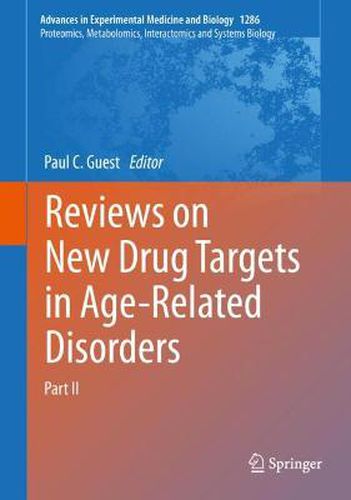Readings Newsletter
Become a Readings Member to make your shopping experience even easier.
Sign in or sign up for free!
You’re not far away from qualifying for FREE standard shipping within Australia
You’ve qualified for FREE standard shipping within Australia
The cart is loading…






This title is printed to order. This book may have been self-published. If so, we cannot guarantee the quality of the content. In the main most books will have gone through the editing process however some may not. We therefore suggest that you be aware of this before ordering this book. If in doubt check either the author or publisher’s details as we are unable to accept any returns unless they are faulty. Please contact us if you have any questions.
Aging is an inevitable part of life, and is becoming a worldwide social, economic and health problem due to the fact that an increasing proportion of individuals in the advanced age category have a higher probability of developing age-related disorders. New therapeutic approaches are still in need to decrease or slow the effects of such diseases in this aging society. Advances in ‘omic technologies such as genomics, transcriptomics, proteomics and metabolomics have significantly advanced our understanding of diseases in multiple medical areas. It is hoped that emerging hits from these analyses might be prioritized for further screening as potential novel drug targets for increasing the human healthspan in line with the lifespan, which will in turn lead to new therapeutic strategies and drug development projects by the pharmaceutical industry. This new book presents a series of reviews describing studies which have resulted in the identification of potential new drug targets for age-related disorders. Much of this information has come from 'omic comparisons of healthy and disease states or from testing the effects of potential new therapeutic approaches. Each chapter will be presented in the context of specific chronic diseases or different therapeutic strategies, providing important information on disease mechanisms related to the aging process. This book will be of interest to researchers in the areas of aging and chronic disease, as well as clinical scientists, physicians, and major drug companies. With contributors from Australia, Brazil, Canada, France, Germany, India, Iran, Iraq, South Africa, South Korea, Thailand, Ukraine, United Kingdom, United States of America, Uruguay and Vietnam, this is a timely follow up to Guest’s previous book Reviews on New Drug Targets in Age-Related Disorders.
$9.00 standard shipping within Australia
FREE standard shipping within Australia for orders over $100.00
Express & International shipping calculated at checkout
This title is printed to order. This book may have been self-published. If so, we cannot guarantee the quality of the content. In the main most books will have gone through the editing process however some may not. We therefore suggest that you be aware of this before ordering this book. If in doubt check either the author or publisher’s details as we are unable to accept any returns unless they are faulty. Please contact us if you have any questions.
Aging is an inevitable part of life, and is becoming a worldwide social, economic and health problem due to the fact that an increasing proportion of individuals in the advanced age category have a higher probability of developing age-related disorders. New therapeutic approaches are still in need to decrease or slow the effects of such diseases in this aging society. Advances in ‘omic technologies such as genomics, transcriptomics, proteomics and metabolomics have significantly advanced our understanding of diseases in multiple medical areas. It is hoped that emerging hits from these analyses might be prioritized for further screening as potential novel drug targets for increasing the human healthspan in line with the lifespan, which will in turn lead to new therapeutic strategies and drug development projects by the pharmaceutical industry. This new book presents a series of reviews describing studies which have resulted in the identification of potential new drug targets for age-related disorders. Much of this information has come from 'omic comparisons of healthy and disease states or from testing the effects of potential new therapeutic approaches. Each chapter will be presented in the context of specific chronic diseases or different therapeutic strategies, providing important information on disease mechanisms related to the aging process. This book will be of interest to researchers in the areas of aging and chronic disease, as well as clinical scientists, physicians, and major drug companies. With contributors from Australia, Brazil, Canada, France, Germany, India, Iran, Iraq, South Africa, South Korea, Thailand, Ukraine, United Kingdom, United States of America, Uruguay and Vietnam, this is a timely follow up to Guest’s previous book Reviews on New Drug Targets in Age-Related Disorders.